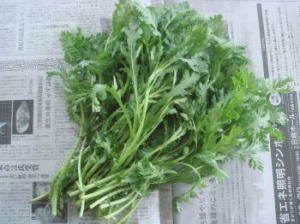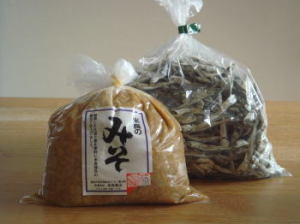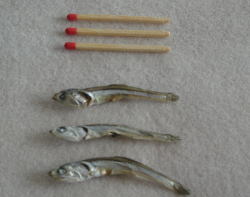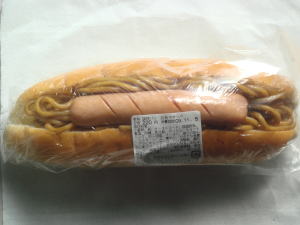Garland Chrysanthemum ― 2009/11/01

Leaf vegetables are one of the winter food attractions in Japan. Spinach, Komatsu-na, Chinese lettuce…thanks to the milder winter climate (and global warming) , we seldom have ground frost or ice. So here there is plenty of supply of vegetables throughout winter.
The Garland Chrysanthemum is one of the winter leaf vegetables. Although this plant has the name “chrysanthemum” which very likely remind you of flower, we consider it a vegetable. Because we eat only its leaves and stems, garland chrysanthemums are harvested when the stems are soft, before they bud. So I haven’t seen the flower of this plant.
With its pleasant flavour and subtly bitter taste, this deep green vegetable is delicious in various dishes; hot-pots, stir-fly, miso soup and so on. My favourite is boiled garland chrysanthemum in vinegar source with a refreshing aroma of an autumn citron.
The garland chrysanthemum is available from October to March, and particularly delicious early in the season; the leaves and stems are so soft that you can enjoy them as a salad vegetable. When the autumn deepened into winter, their texture becomes stringier and tougher, and you might find worms on the stem (after removing the unpleasant things to eat, they are still delicious, though).
The Garland Chrysanthemum is one of the winter leaf vegetables. Although this plant has the name “chrysanthemum” which very likely remind you of flower, we consider it a vegetable. Because we eat only its leaves and stems, garland chrysanthemums are harvested when the stems are soft, before they bud. So I haven’t seen the flower of this plant.
With its pleasant flavour and subtly bitter taste, this deep green vegetable is delicious in various dishes; hot-pots, stir-fly, miso soup and so on. My favourite is boiled garland chrysanthemum in vinegar source with a refreshing aroma of an autumn citron.
The garland chrysanthemum is available from October to March, and particularly delicious early in the season; the leaves and stems are so soft that you can enjoy them as a salad vegetable. When the autumn deepened into winter, their texture becomes stringier and tougher, and you might find worms on the stem (after removing the unpleasant things to eat, they are still delicious, though).
Miso Soup Essentials ― 2009/11/02

You must know what miso soup is; a soup seasoned with soybean paste.
Then, how about local varieties?
I think there are some essential ingredients and a tool to make Fukuokac-style miso soup.
First of all, we tend to use something called barley miso made with barley koji. (Don’t ask me about koji fermentation technology. Wikipedia will tell you all about this matter.) Basically the barley miso is lighter in the colour and sweeter in the taste, compared to the popular rice miso. As the texture of the barley miso is coarser than rice miso, you need this tool to sieve out the miso.
As the texture of the barley miso is coarser than rice miso, you need this tool to sieve out the miso.
For the soup stock, we use boiled-and-dried sardines, either as an additional ingreadient to konbu seaweed and/or smoked bonitoes,or on their own, to get an intense taste and flavour. As the sardines had been processed intact, you should take off the unnecessary parts (heads and guts) so that you can get a soup without unpleasant fishy smell.
As the sardines had been processed intact, you should take off the unnecessary parts (heads and guts) so that you can get a soup without unpleasant fishy smell.
 Some people might even lightly roast them in order to bring out a savoury roasted flavour.
Some people might even lightly roast them in order to bring out a savoury roasted flavour.
Isn’t it a good way to kill time for a jobless person, like me, to follow all those procedure to make a bowl of soup? Actually, I also like, or sometimes prefer, miso soup made with granulated soup stock and pre-filtered miso, or instant miso soup.
Then, how about local varieties?
I think there are some essential ingredients and a tool to make Fukuokac-style miso soup.
First of all, we tend to use something called barley miso made with barley koji. (Don’t ask me about koji fermentation technology. Wikipedia will tell you all about this matter.) Basically the barley miso is lighter in the colour and sweeter in the taste, compared to the popular rice miso.


For the soup stock, we use boiled-and-dried sardines, either as an additional ingreadient to konbu seaweed and/or smoked bonitoes,or on their own, to get an intense taste and flavour.


Isn’t it a good way to kill time for a jobless person, like me, to follow all those procedure to make a bowl of soup? Actually, I also like, or sometimes prefer, miso soup made with granulated soup stock and pre-filtered miso, or instant miso soup.
Today's Cat - 2009/11/04 ― 2009/11/04

A very imposing-looking cat.
On a wall, he looks as if he was the CEO of The Cat & Co. Ltd., who is giving an interview for Forbes Feline Edition.
Endangered Snack ― 2009/11/05

This is the food you must try when you visit Japan. A hot dog bun filled with stair-fried Chinese noodle seasoned with Worcestershire-ish sauce, and a little sausage sliced lengthways. Looks disgusting? Actually, its tastes delicious particularly for those who like tacky food!
Also, there is another reason I recommend: this kind of snack buns may disappear if you don’t try it now.
In this country, where food trend can change dramatically and rapidly, this snack is almost an endangered species. Now something like French breads fermented with home-grown yeast or foccacias made from semolina flour imported from Italy are the mainstream (in this Far-East country!). In fact, you rarely find it at stylish bakeries or boulangeries (they might prefer this title) on high streets.
There is a variation of this bun. Based on the same principle, but the noodles are inside the dough. Is this the Japanese equivalent of Cornish pasty?
Is this the Japanese equivalent of Cornish pasty?
And this is yet another variation. Instead of the Worcestershire-ish sauce and Chinese noodles, this bun holds softly boiled and stir-fried spaghetti seasoned with tomato ketchup (what we call “Napolitano spaghetti”), topped with a sausage made from fish meat (sometimes rabbit, horse, or other animals).
Instead of the Worcestershire-ish sauce and Chinese noodles, this bun holds softly boiled and stir-fried spaghetti seasoned with tomato ketchup (what we call “Napolitano spaghetti”), topped with a sausage made from fish meat (sometimes rabbit, horse, or other animals).
I imagine in the 70s when this type of buns were popular, fish was much cheaper than meat, so fish sausages were commonly used as a substitution for meat sausage. Now the fish sausage has been highly-regarded as a healthier protein, though.
Try a taste of the 70s Japan!
Also, there is another reason I recommend: this kind of snack buns may disappear if you don’t try it now.
In this country, where food trend can change dramatically and rapidly, this snack is almost an endangered species. Now something like French breads fermented with home-grown yeast or foccacias made from semolina flour imported from Italy are the mainstream (in this Far-East country!). In fact, you rarely find it at stylish bakeries or boulangeries (they might prefer this title) on high streets.
There is a variation of this bun. Based on the same principle, but the noodles are inside the dough.

And this is yet another variation.

I imagine in the 70s when this type of buns were popular, fish was much cheaper than meat, so fish sausages were commonly used as a substitution for meat sausage. Now the fish sausage has been highly-regarded as a healthier protein, though.
Try a taste of the 70s Japan!
Today's Catch - 20091105 ― 2009/11/06

As usual...
a small seabream,
a small threadsail filefish, and
numerous mackerel scads and horsemackerels (slightly bigger than before).
When can we have a flatfish for dinner?
a small seabream,
a small threadsail filefish, and
numerous mackerel scads and horsemackerels (slightly bigger than before).
When can we have a flatfish for dinner?
Today's Cat - 2009/11/07 ― 2009/11/07
When I saw him for the first time, I assumed he was harnessed.
. But it has turned out that he actually has a great wardrobe.
The picture I posted before was him in his summer clothing, and now he is wearing pullover and a sweat shirt,
and a sweat shirt,  both with short sleeves.
both with short sleeves.
Now I wonder not only whether his previous life was a docile dog, but how his owner dresses him.
It is not the easiest job to get a cat into sleeved clothes, is it?
. But it has turned out that he actually has a great wardrobe.
The picture I posted before was him in his summer clothing, and now he is wearing pullover


Now I wonder not only whether his previous life was a docile dog, but how his owner dresses him.
It is not the easiest job to get a cat into sleeved clothes, is it?
Hairy Building ― 2009/11/09

Trim your unkempt hair!
This is not a building to laugh at.
Actually this is a half- public, half-commercial building built on the site where the prefectural government office used to stand. The jungle covering the surface of the building is said to be placed in order to create a harmonised view with the park next to this building.
As this monster is built to offer ‘cultural and international interchange’ to the local residents, the management seems to have chosen its ‘dignified’ tenants carefully.
Indeed, there is no fishmonger, Internet café, or secondhand bookshop ( So there is no point for me to go, except for when I want to see something weird). Main tenants are an international organization, concert halls, conference rooms, and a passport service office.
Also, some restaurants and boutiques occupy the lower floors. I don’t know their relationships with the building’s concept; cultural promotion, though.
Anyway, if you would like, you can climb up this little mountain. Entrance is free.
This is not a building to laugh at.
Actually this is a half- public, half-commercial building built on the site where the prefectural government office used to stand. The jungle covering the surface of the building is said to be placed in order to create a harmonised view with the park next to this building.
As this monster is built to offer ‘cultural and international interchange’ to the local residents, the management seems to have chosen its ‘dignified’ tenants carefully.
Indeed, there is no fishmonger, Internet café, or secondhand bookshop ( So there is no point for me to go, except for when I want to see something weird). Main tenants are an international organization, concert halls, conference rooms, and a passport service office.
Also, some restaurants and boutiques occupy the lower floors. I don’t know their relationships with the building’s concept; cultural promotion, though.
Anyway, if you would like, you can climb up this little mountain. Entrance is free.
Shop for Fish ― 2009/11/10
I don’t hate cooking fish that my husband caught. But I definitely prefer shopping fish at a proper shop, if I can choose.
The reason couldn’t be simple: because I don’t have to think about what I cook for dinner. Your fishmonger will suggest the day’s recommendations according to your taste, budget, and your previous shopping. They seem to have a huge database in their brain. Plus, if you buy a whole fish, he will scale, clean, cut, fillet the fish, and make beautiful sashimi for you. What you need is just put the sashimi on your dinner plate and serve. Unlike other ready-made meals, you even don’t have to reheat. And the rest of the fish will be neatly cut for next day’s dinner, such as stew, soup, or baked fish if your fish is big enough.
One day, while my husband were off delightfully fishing, I went to my favourite fishmonger who sells locally caught fish only.
The day’s catch was a sea bream. Huge size, by my standard. While chatting about this and that, he cleaned, cut, filleted, and made sashimi for me, and pack the rest for tomorrow’s soup.
While chatting about this and that, he cleaned, cut, filleted, and made sashimi for me, and pack the rest for tomorrow’s soup.
 Then I told him I would like a squid.
Then I told him I would like a squid.
 Again, he did all those vexing jobs humming a tune while I was chatting about wild flowers and something with his wife.
Again, he did all those vexing jobs humming a tune while I was chatting about wild flowers and something with his wife.

I didn’t even think about how I would cook it, which is a paradise for a housewife who has been tired of thinking how to cook small fish in a huge amount.
You might say it’s cheaper to catch wild fish than shopping. But, you know, the payment to this trustworthy fishmonger includes fees for his professional skills and expert choice of fish.
Otherwise, I can’t explain why fish from this shop is tastier than wild fish.
The reason couldn’t be simple: because I don’t have to think about what I cook for dinner. Your fishmonger will suggest the day’s recommendations according to your taste, budget, and your previous shopping. They seem to have a huge database in their brain. Plus, if you buy a whole fish, he will scale, clean, cut, fillet the fish, and make beautiful sashimi for you. What you need is just put the sashimi on your dinner plate and serve. Unlike other ready-made meals, you even don’t have to reheat. And the rest of the fish will be neatly cut for next day’s dinner, such as stew, soup, or baked fish if your fish is big enough.
One day, while my husband were off delightfully fishing, I went to my favourite fishmonger who sells locally caught fish only.
The day’s catch was a sea bream. Huge size, by my standard.




I didn’t even think about how I would cook it, which is a paradise for a housewife who has been tired of thinking how to cook small fish in a huge amount.
You might say it’s cheaper to catch wild fish than shopping. But, you know, the payment to this trustworthy fishmonger includes fees for his professional skills and expert choice of fish.
Otherwise, I can’t explain why fish from this shop is tastier than wild fish.
最近のコメント